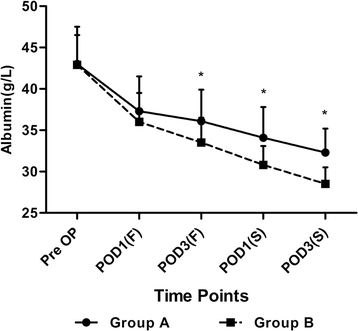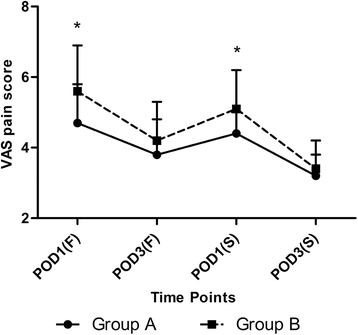Blood management of staged bilateral total knee arthroplasty in a single hospitalization period
- PMID: 25392119
- PMCID: PMC4232703
- DOI: 10.1186/s13018-014-0116-1
Blood management of staged bilateral total knee arthroplasty in a single hospitalization period
Abstract
Introduction: Few literatures have studied the blood management in patients treated with staged bilateral primary total knee arthroplasty (TKA) in a single hospitalization period. Therefore, this study aims to evaluate the effectiveness and safety of the newly introduced multimodal blood management (MBM) in these patients.
Materials and methods: We retrospectively compared the perioperative parameters in 70 cases undergoing staged bilateral primary TKA in a single hospitalization period from 2012-2013 in a single center with two different groups of patients, allocating cases to the group with the newly introduced MBM (Group A, n =33) and controls to the group without the newly introduced MBM (Group B, n =37). The newly introduced MBM protocols include preoperative hemoglobin (Hb) evaluation, high protein diet, tourniquet release after skin closure, preoperative oral iron treatment and femoral canal obturation, and one dose of tranexamic acid (TXA) IV with another one if necessary. While in the control group, only routine blood-saving techniques were used.
Results: Group A had a transfusion rate of 9% (3/33), whereas 32.4% of patients (12/37) in Group B received allogenic blood transfusion. Significant benefits were also found in Group A in terms of postoperative Hb and hematocrit (Hct), reduction of postoperative pain, swelling, postoperative pain, length of stays, and hospital costs. No deep vein thrombosis (DVT) events were found in all these patients.
Conclusions: The newly introduced MBM in staged bilateral TKA in a single hospitalization period can reduce blood loss effectively as well as pain and knee joint swelling instead of leading to increased complications and result in significant cost savings.
Figures




References
-
- Bierbaum BE, Callaghan JJ, Galante JO, Rubash HE, Tooms RE, Welch RB. An analysis of blood management in patients having a total hip or knee arthroplasty. J Bone Joint Surg Am. 1999;81:2–10. - PubMed
-
- Lotke PA, Faralli VJ, Orenstein EM, Ecker ML. Blood loss after total knee replacement. Effects of tourniquet release and continuous passive motion. J Bone Joint Surg Am. 1991;73:1037–1040. - PubMed
Publication types
MeSH terms
Substances
LinkOut - more resources
Full Text Sources
Other Literature Sources
Medical

